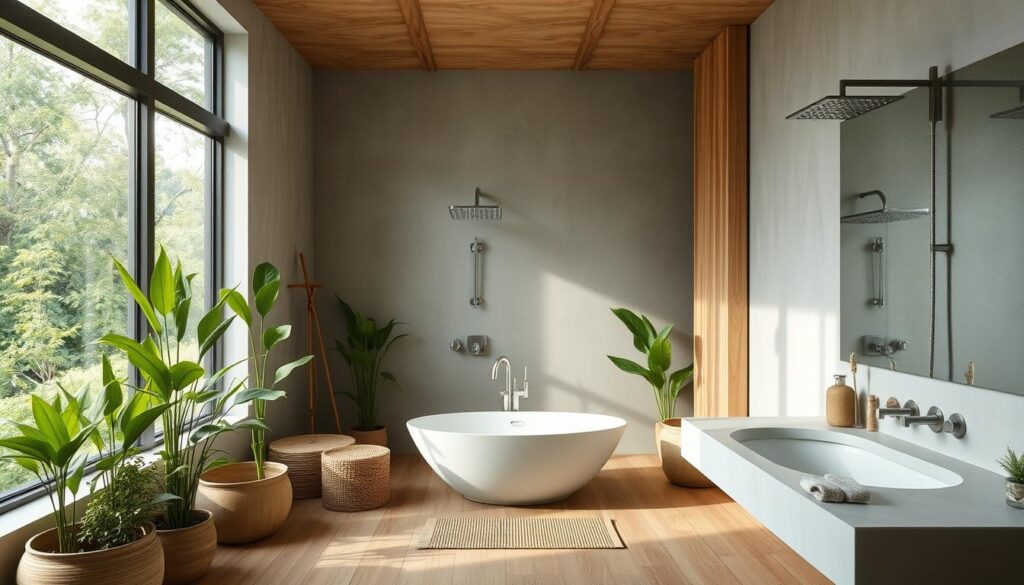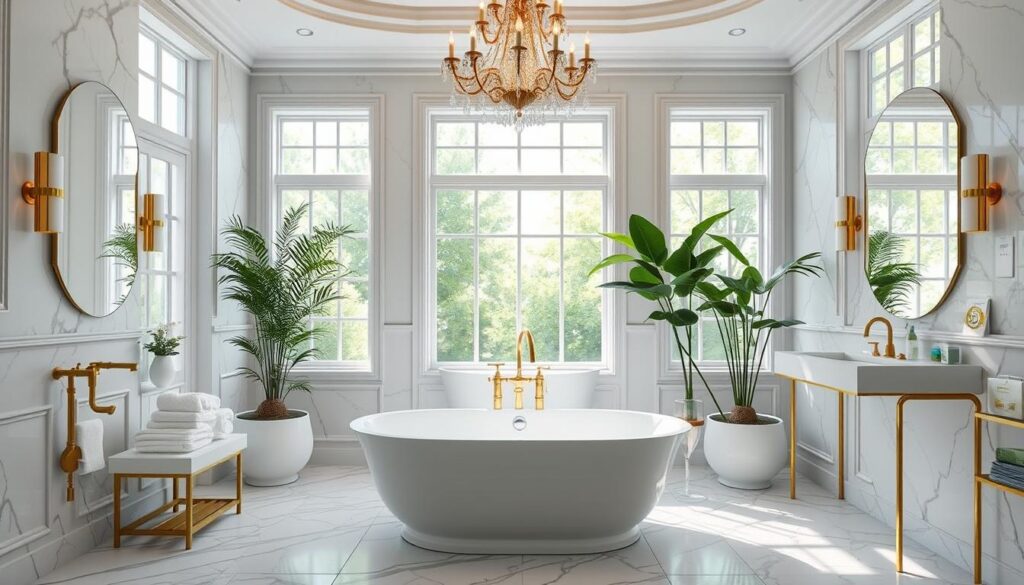
Turn your basement into a movie paradise with home theater design modern basement ideas. These ideas mix style with practicality. A home theater focuses on every detail, like dark colors making screens pop and carpet that absorbs sound.
Imagine a simple setup with a projector and wooden walls, or a cozy space with brick and beams. You can go for a mid-century vibe or a family area with bean bags and popcorn. This guide covers everything from the best viewing spots to adding smart tech.
Even small areas can look great with simple colors. Try combining red walls with recliners or add fiber optics for a unique look. Your basement can be both a place to hang out and a movie lover’s dream.
1. Choosing the Right Space for Your Home Theater
Starting a basement home theater means looking at your space first. The right setup and natural features can make it a perfect movie spot. A good home theater room design starts with these key points.
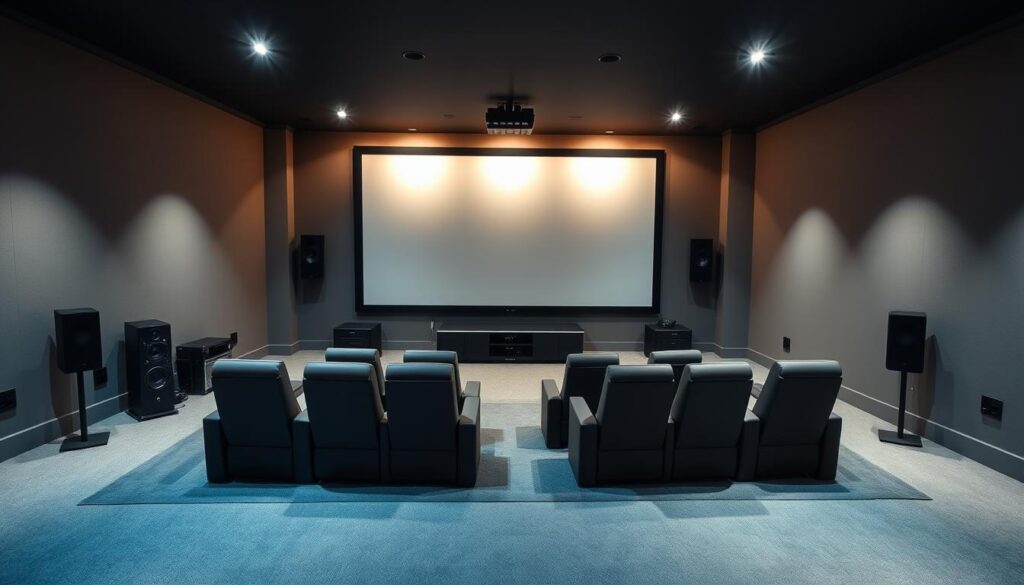
Assessing Your Basement Layout
Get the most out of your basement by measuring it well.
- Make sure seats are far enough away for a good view, about 8–10 feet from the screen.
- Use support columns in your design, like hiding cables behind them.
- Plan paths for easy movement without blocking the view.
Considering Noise Control
Basements are great at blocking outside noise with their concrete walls. To improve this, you can:
- Add acoustic panels to reduce echoes.
- Seal gaps around doors or vents.
- Use thick carpets to soak up sound.
These steps help keep your space quiet and focused.
Evaluating Natural Light Sources
Darkness is key for a great movie experience. If your basement has windows:
- Put up blackout shades to stop glare.
- Choose dimmable LED lights for mood.
Daylight isn’t needed; you want controlled darkness for better visuals.
| Factor | Benefit | Action Step |
|---|---|---|
| Soundproofing | Blocks outside noise and vibrations | Use acoustic foam or double-layer drywall |
| Space Utilization | Flexible layout options | Map seating around the screen |
| Lighting Control | Enhances screen visibility | Install dimmable LED strips |
2. Essential Home Theater Equipment
Creating a modern home theater setup begins with the right gear for your basement entertainment room. Every piece should boost comfort and dive you into the action without costing too much.
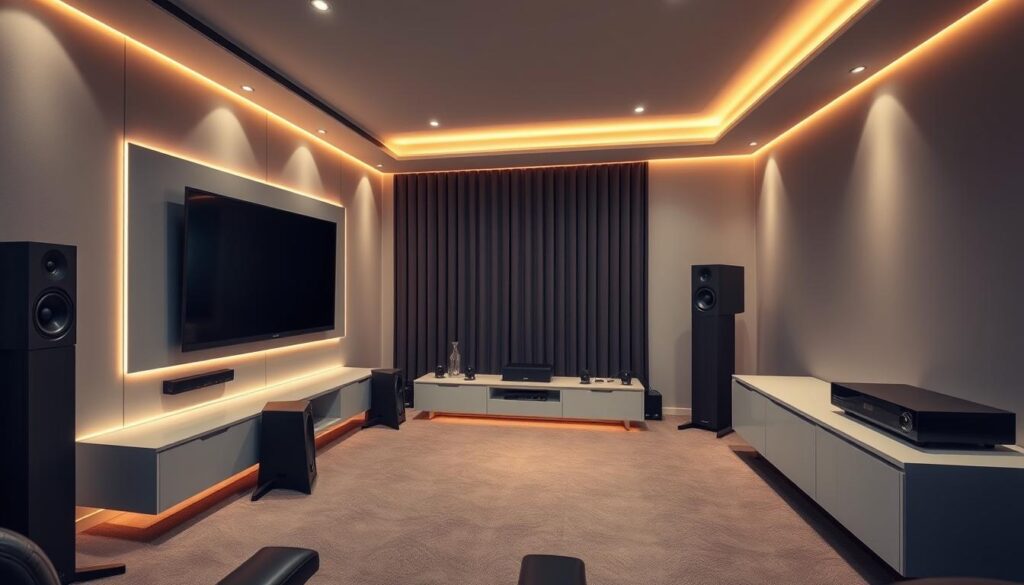
Audio Systems: Finding the Right Fit
Surround sound systems, like Dolby Atmos or 5.1 setups, make audio feel real. Brands like Sonos or Yamaha are great for easy setup. For small areas, think about in-wall speakers from Peerless-AV or a soundbar.
Use a Sanus VMPL50A-B1 mount for your TV and Monoprice’s 4K HDMI cables for clear signals. A subwoofer, like the Klipsch Reference, adds deep bass.
- Soundbars for compact spaces
- In-wall speakers for sleek designs
- Universal remotes like Sofabaton for simplified control
Visual Displays: Projectors vs. TVs
| Feature | Projectors | TVs |
|---|---|---|
| Screen Size | Up to 200” | Up to 85” |
| Space Needs | Requires ceiling mounting | Wall or stand mounting |
| Cost | Higher upfront but affordable long-term | Lower initial cost |
Projectors, like Epson’s Home Cinema series, offer big screens. Vizio’s 85” TVs give you bright 4K pictures. Use blackout curtains to improve contrast.
Seating Options for Comfort and Style
Choose seats that fit your space and taste:
- Recliners from La-Z-Boy with cup holders and USB ports
- Sectional sofas for group gatherings
- Bean bags for budget-friendly setups
Make sure aisles are wide for easy movement. Add pillows and rugs for a cozy feel.
3. Lighting Solutions for Your Basement Theater
Lighting makes your basement theater feel special, mixing style with function. The right lights turn a room into a movie theater without glare. Modern designs use sleek LED lights and stylish touches for both looks and comfort.

“LED TV backlight with decorative wood panelling. A warmer LED glow may be more fitting, but a great setup nonetheless. Backlighting and wall paneling done right.”
Ambient vs. Task Lighting
Find lights that do more than one thing. Recessed lighting gives a soft, overall light. LED strips along edges add flair without being too bright. Wall sconces with adjustable shades provide task light for side tables, keeping the focus on the screen.
Dimming Features for Atmosphere
- Adjustable dimmers let you shift from bright setup mode to total darkness for movies.
- Preset scenes like “Movie Night” or “Social Hour” save favorite settings.
- Automated systems can lower lights at sunset or sync with movie scenes for dramatic effects.
Smart Lighting Options
Modern designs love tech. Voice-controlled systems let you change lights with a voice command. Geometric LED panels that pulse to music or change colors for themed nights add flair. Even simple setups like fiber optic star ceilings create wow moments without breaking the bank.
Use sleek designs like minimalist pendants or hidden LED cove lighting. This keeps the space looking clean and high-tech.
4. Acoustic Optimization for Better Sound
Acoustic optimization turns a basement into a theater with clear sound. For home theater room design, it’s important to balance sound absorption, reflection, and room shape. This avoids echoes and muddy bass. Follow these steps to make your space an audio sanctuary without losing style.
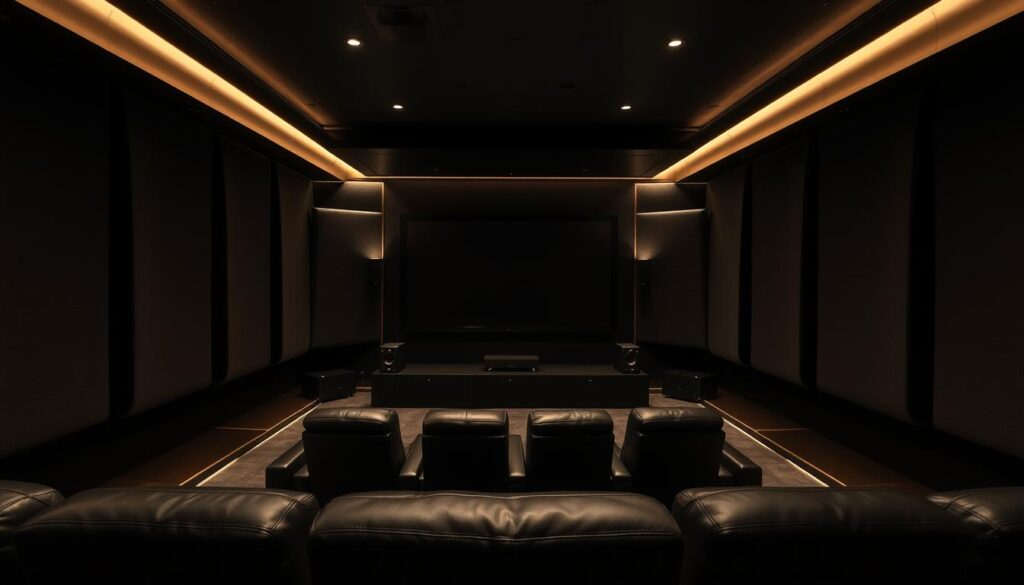
Soundproofing Techniques to Control Noise
Concrete basement walls reflect sound. Start by sealing gaps and adding mass-loaded barriers. Use double-layer drywall with Green Glue compound for walls, and acoustic caulk around outlets.
For noise isolation, add 1-inch fiberglass insulation between wall studs. Test speaker placement with tools like REW to adjust crossover points and reduce standing waves.
Acoustic Panels as Design Elements
“Acoustic panels aren’t just functional—they’re now a modern design staple in contemporary basement design,” says acoustics expert Dave Rathe.
Hang fabric-wrapped panels in geometric patterns or use wood slat walls for texture. Brands like ATS Acoustics offer panels in sleek, minimalist designs. Bass traps in corners absorb low frequencies, while perforated metal panels add industrial flair.
These materials cut echo without sacrificing style.
Flooring Choices That Shape Sound Quality
- Engineered hardwood with underlayment dampens foot traffic noise while resisting basement moisture.
- Luxury vinyl tiles (LVT) provide a hard surface for bass response but pair well with area rugs for mid-range absorption.
- Cork tiles soften highs without deadening sound, making them ideal for home theater room design floors.
Pair these choices with subwoofers placed symmetrically near corners for even bass distribution. Adding a house curve with a parametric EQ fine-tunes the final sound profile.
5. Modern Aesthetic Design Elements
Turn your basement into a sleek basement design wonder by mixing looks and use. A minimalist home theater room needs clean lines and smart details. These make any space feel like a movie theater. Begin with a base that shows off simplicity and style.
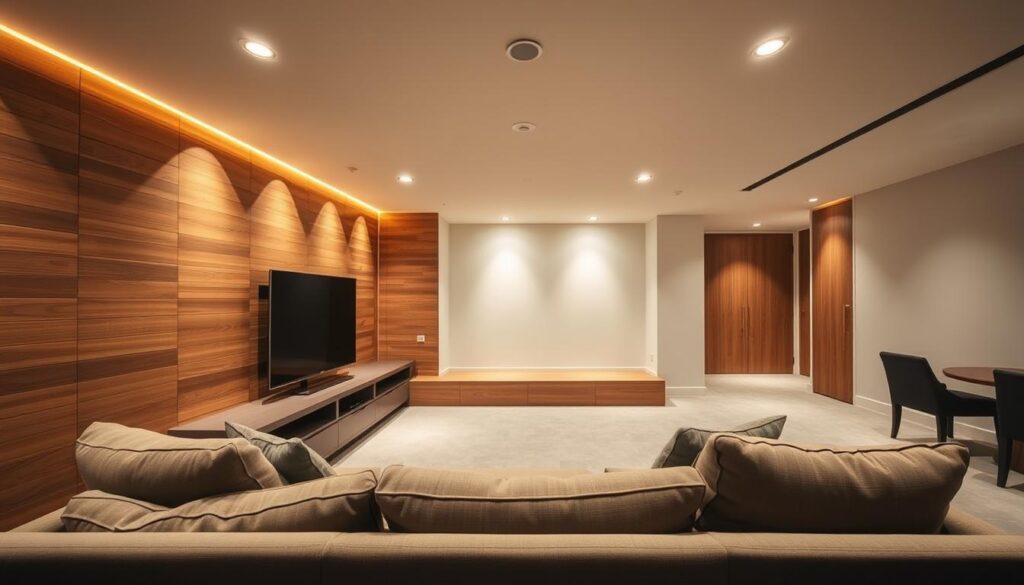
Color Schemes for a Cinematic Feel
Use neutral colors like gray, beige, and white to start. They offer a clean background for bold touches. Mix dark walls with light seats for a nice contrast. Think charcoal-gray walls with ivory leather chairs.
Add some life with:
- Geometric patterned rugs in metallic tones
- Abstract artwork in bold hues
- Blackout curtains with subtle texture
Incorporating Modern Furniture Styles
Look for furniture that’s both comfy and modern. Choose:
| Option | Features |
|---|---|
| Recliners | White leather with built-in cupholders |
| Sectionals | Low-profile designs in charcoal or slate |
| Ottomans | Storage options with geometric patterns |
Decorative Touches that Impress
Add subtle touches to make spaces stand out:
- Wood slat accent walls in walnut or oak
- Track lighting with adjustable spotlights
- Hidden storage compartments in sleek cabinetry
“A minimalist home theater room prioritizes purposeful design—every element should serve both beauty and function.”
Use soundproofing materials like acoustic panels with abstract wall art. Mix textures without making it messy. Velvet throws and matte-finish walls work well. This creates a space that looks great and feels welcoming.
6. Creative Thematic Ideas for Your Home Theater

Turn your basement entertainment room into a themed getaway that shows off your interests. Whether you love sci-fi or classic movies, these home theater design modern basement ideas let you express yourself. Pick a theme and decorate with details that match it.
Movie Genre-Inspired Designs
- Sci-Fi: Use bright lights and black finishes to look like the future.
- Retro Nostalgia: Choose velvet seats and old posters for a 1950s feel.
- Adventure: Add fake rock walls and secret spots for a treasure hunt vibe.
Family-Centric Themes
Mix fun and family memories with:
- Shelves for family photos
- Flexible seating for movies or homework
- A snack bar with storage for treats and games
Sports Fanatic Spaces
Make a space for sports fans with:
| Theme Element | Implementation Idea |
|---|---|
| Team Colors | Paint walls in favorite sports team hues |
| Memorabilia | Display autographed jerseys in acrylic shadowboxes |
| Seating | Install Tuscany Ultimate Luxury recliners in team colors |
Mike Wat’s mid-century modern home theatre mixes old posters with a Samsung The Wall TV. It shows you can have both style and tech. Let your creativity lead your home theater design modern basement ideas while keeping it practical.
7. Multi-Function Spaces Beyond Movies
Your basement media room can be more than just a place for movies. With modern basement design ideas, it can become a central spot for family activities. Think games, workouts, or creative projects. The goal is to make every area useful without looking messy.
“Natural materials and an open concept make this the perfect room for a movie, a party, or both!”
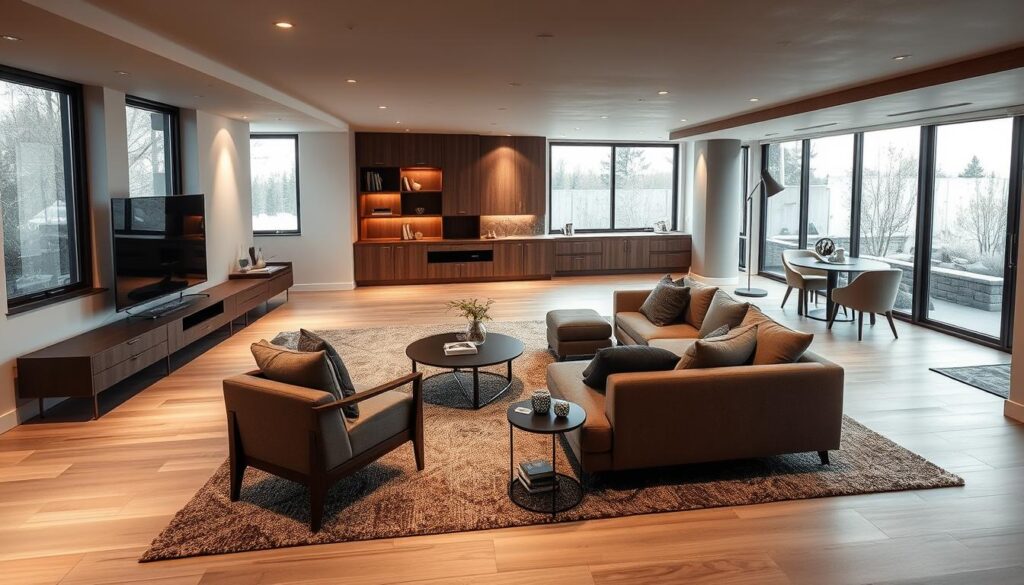
Game Rooms Included in Your Design
Create a space where fun never ends. Add:
- Retro arcade cabinets or modular setups for consoles and board games.
- Storage units that hide game accessories when not in use.
- Soft seating or bean bags for casual hangouts during breaks.
Workout Areas in Adjacent Spaces
Soundproof rooms next to your basement media room are great. Include:
- Foam padding or rubber flooring to muffle exercise noise.
- Motorized screens that fold up to reveal exercise equipment storage.
- Sliding doors with sound-absorbing panels for privacy.
Craft Areas for Family Activities
Make empty corners into creative spots. Try:
- Rolling carts for art supplies or DIY projects.
- Wall-mounted pegboards to display tools or seasonal decor.
- Convertible tables that expand for group projects or fold flat for extra floor space.
Small details like under-cabinet lighting or magnetic walls add to the space. Choose furniture that does more than one thing. This keeps the area open and welcoming for everyone.
8. Smart Home Integration for Your Theater
Turn your basement into a top-notch entertainment area with smart tech. Today’s home theaters mix style with ease, making your basement both smart and fun. Begin by linking all gadgets to a central hub for easy control.
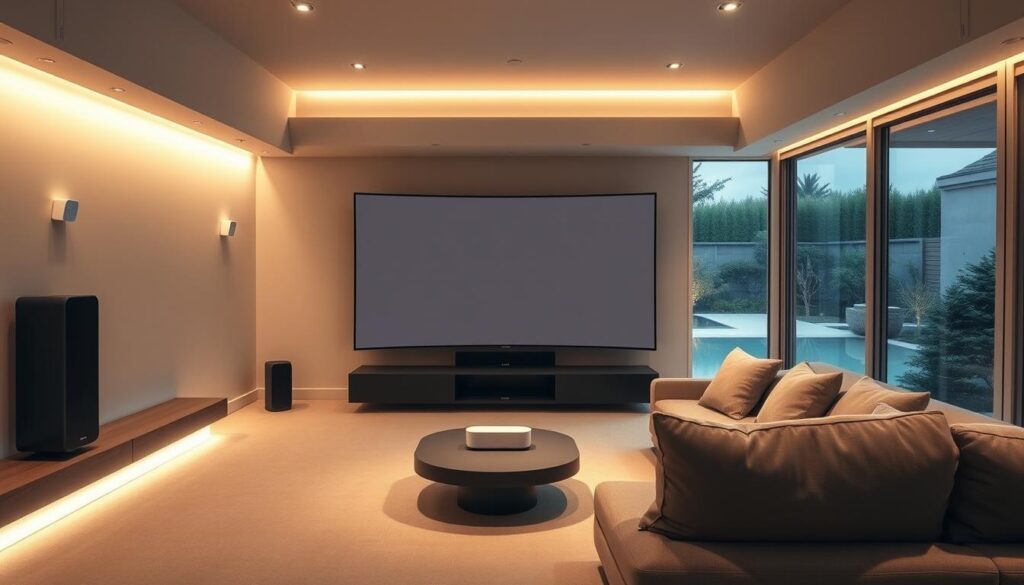
Home Automation Systems
Enjoy a unified experience with these smart features:
- Mobile apps let you control lights, sound, and climate with a tap.
- Custom modes like “Movie Night” adjust everything with one command.
- Automated step lights guide you safely without interrupting the show.
Streaming Services Setup
Make media access easy with:
- Unified platforms manage Netflix, Hulu, and Disney+ in one app.
- Optimized Wi-Fi extenders for better basement connectivity.
- 4K streaming devices and high-end projectors for clear visuals.
Voice Control Features
Hands-free operation is essential for modern setups:
- Use phrases like, “Play Top Gun: Maverick” or “Dim lights to 30%.”
- Smart speakers control surround sound and blackout shades instantly.
- Custom voice commands fit your needs, from snacks to scene settings.
Even simple additions like voice-activated outlets or remote blinds add value. Smart home systems grow with your basement, keeping your theater up-to-date with tech.
9. Budgeting for Your Home Theater Project
Setting up a basement or minimalist home theater doesn’t have to be expensive. Focus on what’s essential like sound and screens. Look for deals on decor and furniture to save money. This guide helps you spend wisely, mix DIY with professional work, and choose affordable yet stylish items.
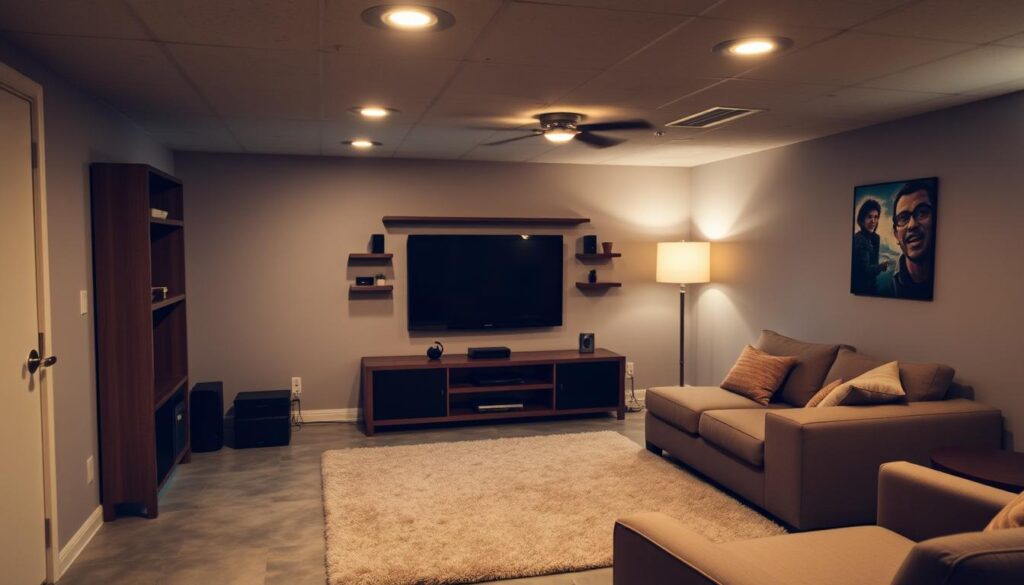
First, split costs into main equipment and design. A Epson Home Cinema 4010 projector and Elite Screens Sable Frame screen cost $1,200 together. Add mid-range speakers like Polk Audio 265 or a Vizio 5.1 soundbar ($350) for great sound. Use paint and LED strips for design instead of custom walls to save.
DIY tasks like hanging curtains or installing Commercial Electric LED Ultra Slim lights can save money. But, wiring or acoustic panels might need a pro. Compare costs: hiring a contractor for soundproofing costs $1,500–$3,000. DIY options like acoustic panels from Home Depot cost under $500.
Use old furniture or thrift stores for seating. A minimalist room looks great with IKEA KIVIK sofas. Monroe sconces are good for lighting and save on in-wall wiring. Brands like Monoprice offer subwoofers under $300. Buy essentials first, then upgrade decor later.
10. Maintenance Tips for Your Basement Theater
Keeping your basement media room in top shape is key. It ensures it remains a go-to spot for years. Simple habits can keep your space looking and working great. Start by shielding your gear from dust and moisture, common basement foes.
Keeping Equipment in Top Shape
Use a soft cloth to dust vents and electronics. A dehumidifier helps control moisture, stopping mold near projectors or screens. Check cables for damage and use Monster Cable organizers to keep them tidy.
Reapply soundproofing caulk around windows every year. This helps block outside noise.
Cleaning Techniques for a Fresh Space
Use a vacuum’s soft brush to clean acoustic panels. Clean your seats weekly with a microfiber cloth. For leather, use eco-friendly cleaners like Method’s.
Avoid spraying liquids on electronics. Vacuum your carpeted floors monthly to reduce allergens.
Upgrading Components Over Time
Future-proof your setup by leaving room for new tech. Use HDMI 2.1 ports for 4K projectors and keep cable runs easy to access. When updating, choose brands like Sonos for sound systems or Samsung for screens.
Smart switches, like Lutron Caseta, let you control lights or projectors with your hands.
Small upkeep steps keep your theater running smoothly. Proper maintenance protects your investment and keeps the space inviting. A well-maintained basement media room adds lasting value to your home. It ensures movie nights, game sessions, or family time remain enjoyable.
More Home Theater Design Modern Basement Ideas
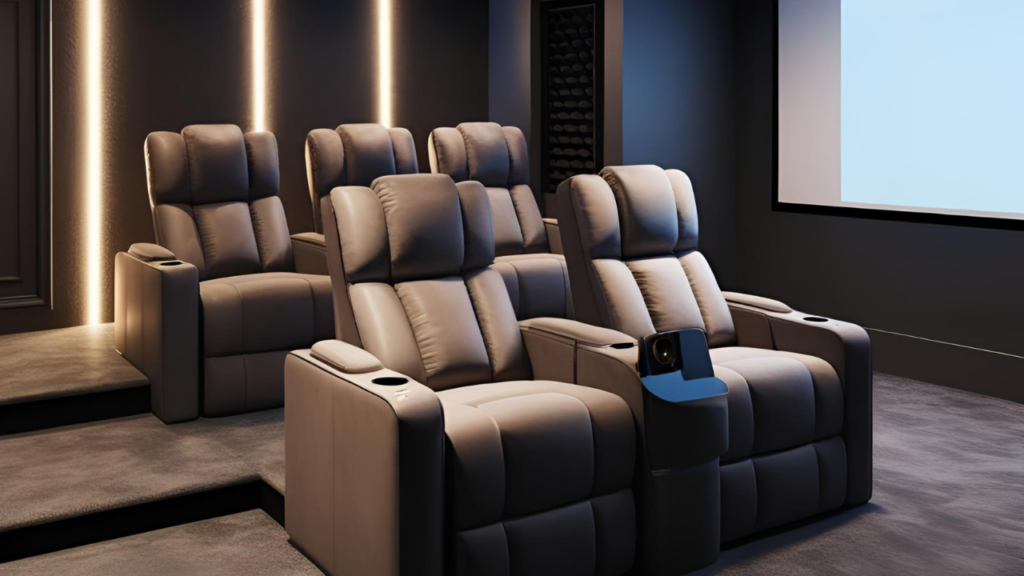
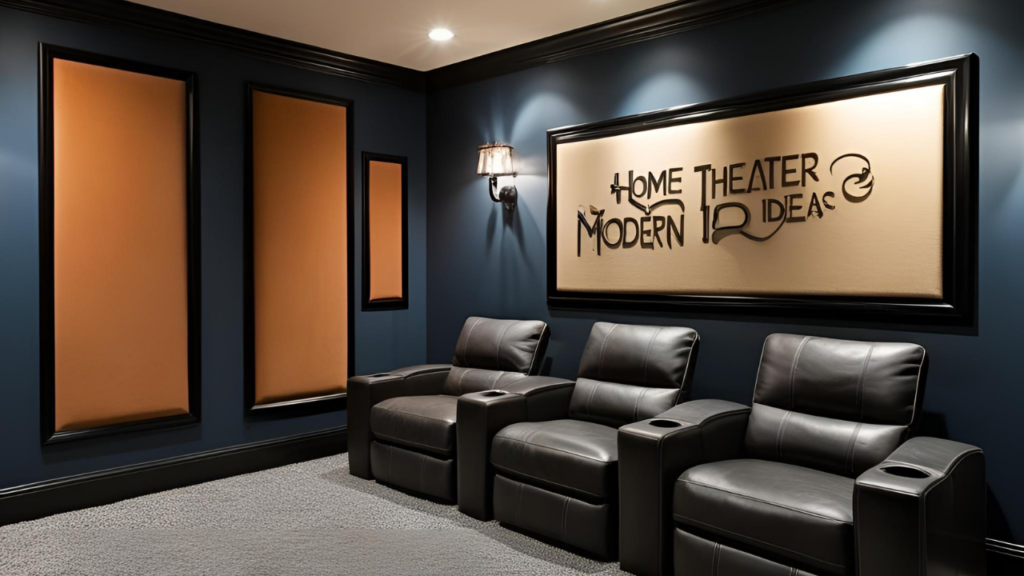
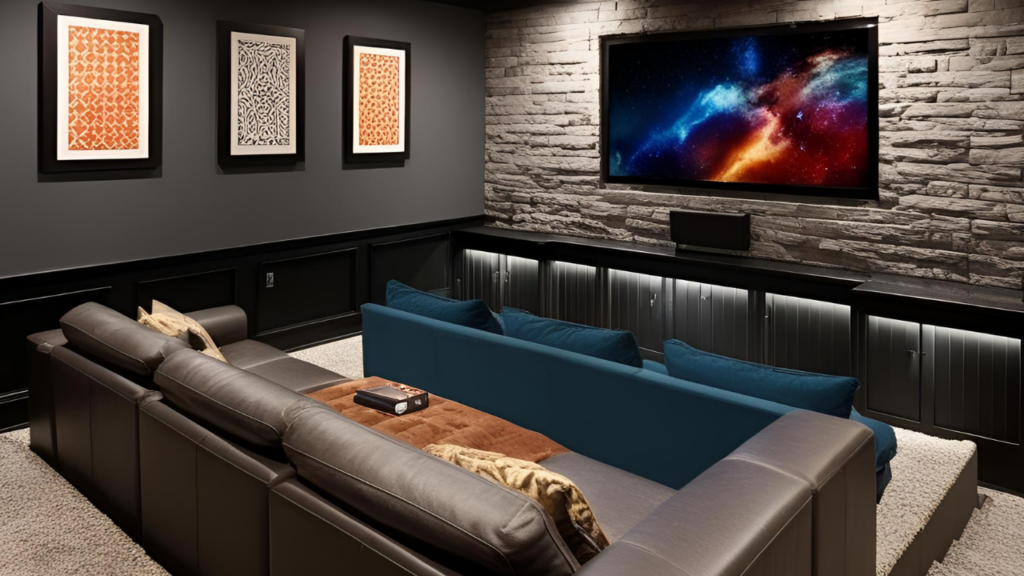

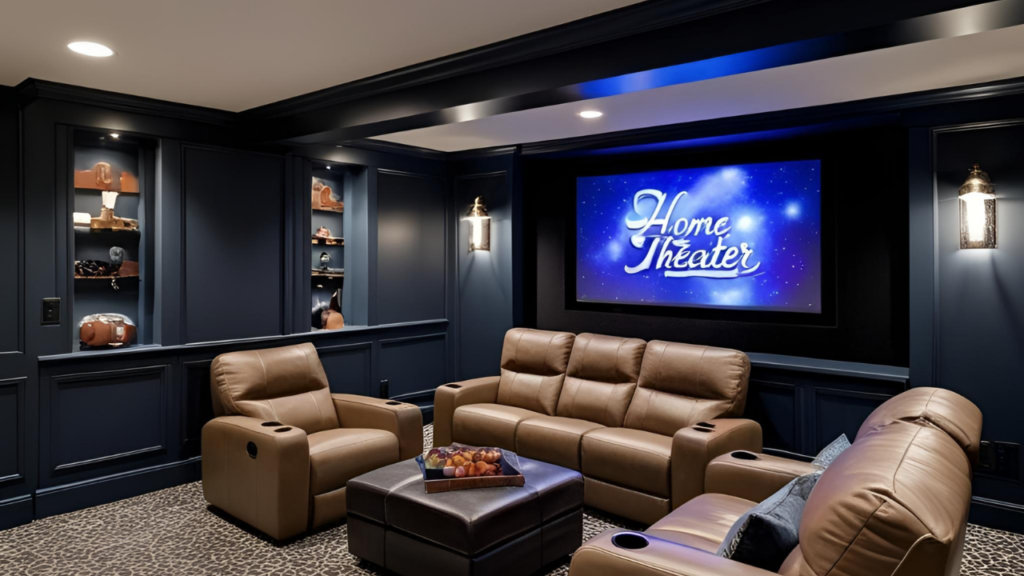

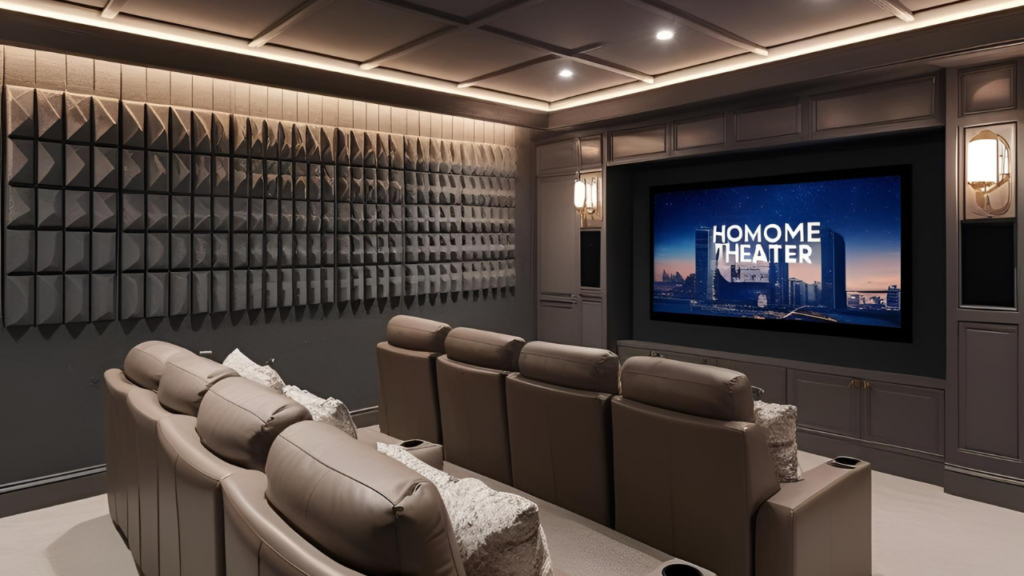

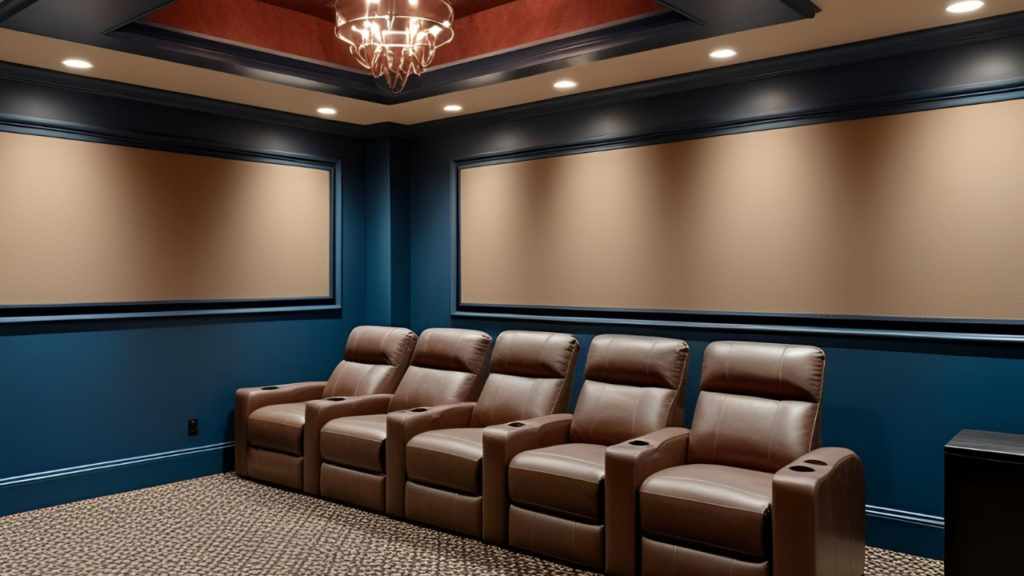
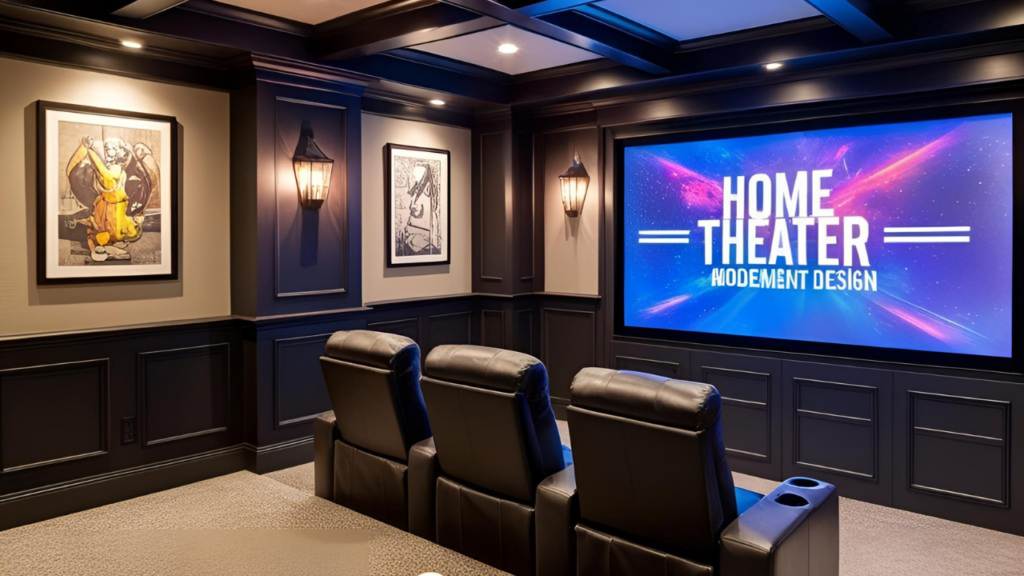
FAQ
What are the benefits of converting my basement into a home theater?
Turning your basement into a home theater is smart. It uses space well, blocks out sound, and boosts your home’s value. It’s a great way to enjoy movies and shows in a cozy setting.
How can I assess my basement layout for a home theater?
First, measure your basement’s size and height. Look at any pillars or systems and how they fit into your design. A good layout is key to a great theater experience.
What equipment do I need for a basement home theater?
You’ll need a good sound system, a projector or big TV, and comfy seats. Pick what fits your space and budget, focusing on quality over quantity.
How does lighting affect my theater experience?
Good lighting reduces eye strain and sets the mood. Use dimmable lights like LED strips or sconces for different moods, from movies to gaming.
What should I do about sound in my basement theater?
Improve sound by soundproofing and using acoustic panels. The right flooring also helps with sound quality.
How can I create a stylish design for my basement theater?
Choose modern colors, sleek furniture, and decor that’s both stylish and comfy. Add touches like wood slats or wall art to make it special.
Can I have a multi-functional basement that includes a home theater?
Yes! Design areas for gaming, workouts, or crafts alongside your theater. Use dividers and soundproofing to keep the theater area clear.
What smart home technology can enhance my basement theater?
Smart systems control lights, sound, and climate easily. Look into voice control and streaming services for a better experience.
How do I budget my basement theater project?
Break down costs for gear, construction, and furniture. Focus on what’s most important and DIY what you can to save money.
What maintenance is needed for my basement home theater?
Clean your projector and screen often, check your sound system, and keep everything dust-free. Watch for moisture to protect your tech.

